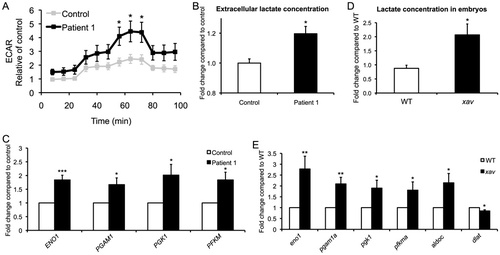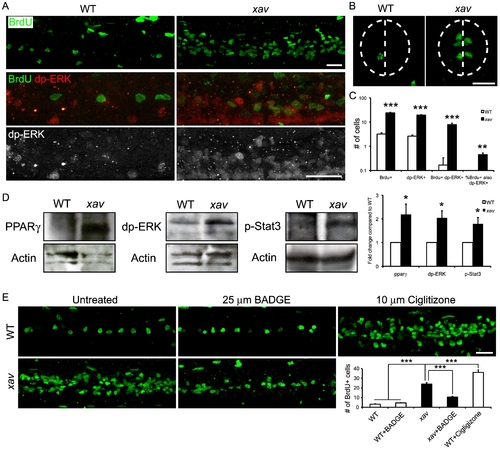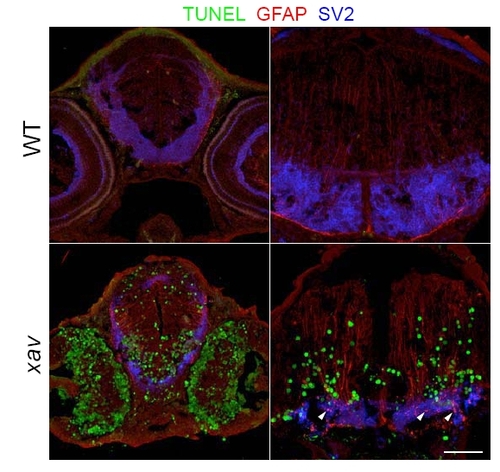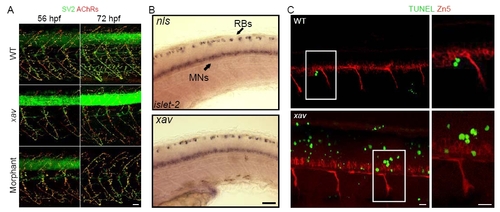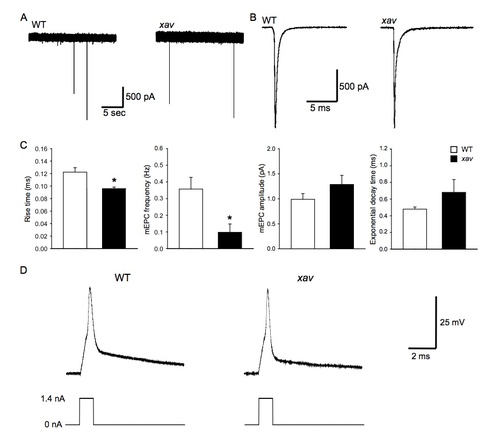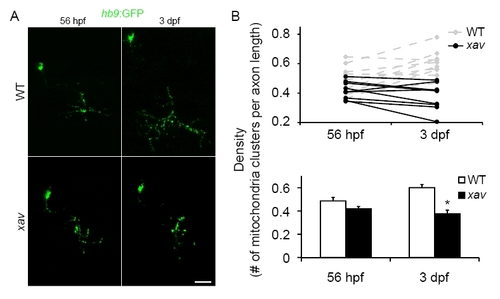- Title
-
Mechanisms Underlying Metabolic and Neural Defects in Zebrafish and Human Multiple Acyl-CoA Dehydrogenase Deficiency (MADD)
- Authors
- Song, Y., Selak, M.A., Watson, C.T., Coutts, C., Scherer, P.C., Panzer, J.A., Gibbs, S., Scott, M.O., Willer, G., Gregg, R.G., Ali, D.W., Bennett, M.J., and Balice-Gordon, R.J.
- Source
- Full text @ PLoS One
|
External phenotype, genotype, cloning and morpholino phenocopy of xav mutants. A. External xav and etfdh morphant (MO) phenotypes at ∼60 hpf include a bent and thinner tail and smaller head and eyes. Scale bar = 100 μm. B. xav mutants and MO exhibit slower heart beat (WT 158±6 beats/minute, N = 13 embryos; xav 87±7; N = 14 embryos; MO 65±7, N = 14 embryos; one-way ANOVA, followed by Dunn′s pairwise comparison, * p<0.001. C. Genetic and physical map of the xav (zgc:92093) locus (red), including microsatellite and SSR markers, number of recombinants, and BAC clones from the T51 radiation hybrid panel. D. etfdh mutation in xav is a T to A mutation (blue box) resulting in a premature stop codon (red box). The amino acid sequence of etfdh is highly conserved among several species, from C. elegans to human. E. Schematic location of xav mutation, resulting in truncation of the C terminal. etfdh MO is predicted to give rise to a protein fragment lacking all functional domains. PHENOTYPE:
|
|
xav mutants exhibit mitochondrial dysfunction. A. Measured rates of state 3 respiration supported by oxidation of α-ketoglutarate and fatty acids (palmitoylcarnitine and octoylcarnitine (each + malate)) showed a 30?35% reduction in xav mutant compared to WT embryos at ∼56 hpf (values normalized to WT; α-ketoglutarate in xav, 0.72±0.10; N = 4 experiments 50?100 embryos each; Student′s t test, * p = 0.03; fatty acid 0.65±0.10 in xav; N = 4 experiments 50?100 embryos each; Student′s t test, * p = 0.02). B. Membrane potential generated by oxidation of α-ketoglutarate and fatty acids was estimated using TMRE and spectrofluorometry, showing a 55% increase in xav compared to WT at ∼56 hpf (values normalized to WT; α-ketoglutarate xav 1.55 ± 0.15; N = 4 experiments 50?100 embryos each; Student′s t test, *** p<0.001) and a 50% reduction (fatty acids xav 0.53±0.07; N = 5 experiments 50?100 embryos each; Student′s t test, *** p<0.001). C. Measured O2 consumption rates with ascorbate/TMPD showed a 40% increase in xav compared to WT at ∼56 hpf (values normalized to WT; xav 1.39±0.13; N = 6 experiments 50?100 embryos each; Student′s t test, * p = 0.014). D?E. Western blot showed that while the total level of AMPK is unchanged in xav, the amount of activated AMPK (phospho-AMPKαThr172) protein is significantly increased. Quantification showed a 2.3 fold increase in xav mutants compared to WT embryos (values normalized to WT; xav 2.3±0.6; N = 3 experiments 30 embryos each; Student′s t test, * p<0.05). F. Levels of ATP production showed a ∼45% reduction in xav mutants compared to WT embryos (WT 20.6±2.6 nmol per mg protein; xav 11.3±2.3 nmol per mg protein; N = 9 replicates, 50?100 embryos each, Student′s t test, * p<0.05). G. mRNA levels of genes involved in mitochondrial function and biogenesis were analyzed with qRT-PCR. A ∼30?40% reduction was observed in mt-nd5 and ndufs1, and a ∼2.4, 1.5 and 2.8 fold increase was observed in pgc-1β, esrrα and pparγ in xav mutants compared to WT. Expression of zebrafish uncoupling protein 4 (fucp4) was increased ∼6 fold, while expression of ucp2 was unchanged (N = 3?4 replicates, 20 embryos each; Student′s t test, * p<0.05, ** p<0.01, *** p<0.001). H. The oxidative fluorescent dye DHR-123 was used to measure cellular superoxide production in live embryos and showed higher cellular superoxide levels in xav mutants compared to WT, especially in the nervous system, including in the spinal cord. Scale bar = 100 μm. I. Expression profile of genes known to be involved in the ROS pathway was assayed with qRT-PCR and showed a ∼50% reduction of catalase transcripts and ∼5 fold increase of glutathione reductase and hspa9 in xav compared to WT (N = 3 replicates, 20 embryos each; Student′s t test, * p<0.05, ** p<0.01). PHENOTYPE:
|
|
Increased aerobic glycolysis in MADD fibroblasts and mutants. A. ECAR was measured in intact control and MADD Patient 1 fibroblasts under basal conditions, following the addition of the mitochondrial inhibitor oligomycin (0.5 µg/ml), in the presence of the uncoupler CICCP (3 µM) and following the addition of the complex I inhibitor rotenone (100 nM). A trend towards higher ECAR rate was seen under basal conditions, and a significant 2-fold increase was observed after uncoupler CICCP treatment in Patient 1 fibroblasts compared to control. (N = 3 experiments, 7?9 replicates of cells from passage 7?12; Student\′s t test, * p<0.05). B. Lactate present in the culture medium showed a ~20% increase in the basal lactate production in Patient 1 fibroblasts compared to control (N = 2 experiments, 5?6 replicates of cells from passage 7?8; Student′s t test, * p<0.05). C. qRT-PCR analyses of genes involved in glycolysis showed glycolytic enzymes enolase 1 (ENO1), phosphoglycerate mutase 1 (PGAM1), phosphoglycerate kinase 1 (PGK1) and phosphofructokinase (PFKM), were increased by ~1.9, 2.7, 3.4 and 3.1 fold respectively in Patient 1 fibroblasts compared to control (N = 5 replicates of cells from passage 7?9; Student′s t test, * p<0.05, *** p<0.001). D. Lactate levels showed a ~2.4 fold increase in xav mutants compared to WT embryos at ~56 hpf (N = 7?9 replicates, 30?100 embryos each; Student′s t test, * p<0.05). E. qRT-PCR analyses of gene expression revealed increased expression of glycolytic enzymes eno1, pgam1a, pgk1, pfkma, and fructose-biphosphate aldolase C (aldoc) by 2.8, 2, 1.9, 1.8 and 2.1 fold respectively, as well a ~20% decrease in PHENOTYPE:
|
|
xav mutants exhibit increased neural cell proliferation as a result of increased glycolysis, due to perturbation of the PPARG-ERK pathway. A. Whole mount embryos labeled with BrdU to mark cells undergoing proliferation. The number of BrdU+ cells was significantly increased in the nervous system, especially in the spinal cord, in xav mutants compared to WT embryos at ∼56?60 hpf. Increased dp-ERK+ cells and BrdU+/dp-ERK+ double labeled cells in the spinal cord in xav mutants compared to WT embryos at ∼56?60 hpf. B. In spinal cord cross-sections from xav mutants and WT embryos at ∼56?60 hpf, BrdU+ cells are distributed peri-ventricularly, suggesting that they are likely to be neural progenitor cells. Dashed line outlines the spinal cord and indicates the midline. Scale bar = 20 μm. C. Quantification of BrdU+ and dp-ERK+ cells at ∼56?60 hpf. Per spinal cord hemisegment: BrdU+ cells WT 3.2±0.4, xav 24±1.4; dp-ERK+ cells WT 2.6±0.3, xav 19.4±0.8; BrdU+/dp-ERK+ WT 0.2±0.2, xav 7.8±1.2. Percent of BrdU+ cells that are also dp-ERK+: WT 3.6%±3.6%, xav 45%±8% (N = 4-19 embryos, >2 carrier pairs; Student′s t test, *** p<0.001). D. Western blot analyses of pparγ, dp-ERK and phospho-STAT3 expression showed dramatic increase in xav compared to WT embryos at ∼56?60 hpf (N = 3 replicates, 30 embryos each; Student′s t test, * p<0.05). E. BrdU labeling of proliferating cells in whole mounts of spinal cord of WT embryos, xav mutants, WT treated with 25 μm BADGE, xav mutants treated with 25 μm BADGE and WT treated with 10 μm Ciglitizone at ∼56?60 hpf. Embryos were raised in BADGE or Ciglitizone from 24 to 60 hpf. Per spinal hemisegment: BrdU+ cells WT 3.2±0.4, WT + BADGE 4.5±0.3, xav 24±1.4, xav + BAGDE 10.6±0.9, WT + Ciglitizone 36±2.5 (N = 6?19 embryos, >3 carrier pairs; one-way ANOVA, followed by Bonferroni′s multiple comparison test, *** p<0.001). PHENOTYPE:
|
|
Nonsense mediated decay and nonsense mediated alternative splicing of etfdh transcript in xav, and morpholino knock down of etfdh. A. qRT-PCR showed that there is a significant, ∼80% reduction of etfdh mRNA in xav, likely due to nonsense mediated decay. N = 3 pools of 20 embryos each for WT and xav; Student′s t test, * p<0.0001. B. xav mutants showed nonsense mediated alternative splicing. As a result of the mutation, which resides in exon11, the exon10-exon13 junctions are mis-spliced in mutants, resulting in transcripts that are predicted to encode proteins lacking critical domains or truncated. Blue arrows indicate primer location. These results suggest that the xav mutation is likely to be loss of function. C. A splice-blocking morpholino against intron2-exon3 (MOI2E3) was designed for etfdh. D. Injection of 8 ng etfdh MOI2E3 in WT embryos, results in >80% reduction of the normal transcript at 2 and 3 dpf, producing a mis-spliced transcript that lacks exon3. Red arrow indicates the MO location and blue arrows indicate primer location. |
|
xav mutants display polycystic kidney like phenotypes. Immunostaining of whole mount zebrafish embryos revealed that the cilia in the pronephric ducts, as labeled by immunostaining with anti-acetylated tubulin antibody, appear distended and irregularly thickened, and contain gaps, in xav mutants compared to WT embryos at ∼60 hpf. Pronephric duct epithelial cells, as labeled by immunostaining with the anti-NaK ATPase antibody α6F, appear irregular in shape and showed aberrant clustering in xav embryos. N = >10 xav and WT embryos for each immunostaining assessment. Scale bar = 20 μm. PHENOTYPE:
|
|
xav mutants exhibit respiratory deficiency. A. Polarographic traces showing O2 consumption by mitochondria in WT and xav homogenates. Freshly prepared homogenates from WT and xav embryos were incubated in an oxygen sensor chamber, and O2 consumption (y axis) as a function of incubation time (x axis) was recorded. In the upper panels, homogenates were incubated with α-ketoglutarate + malate, and in the lower panels, homogenates were incubated with fatty acid (C16 carnitine + malate). Maximal rates of electron transfer were determined from the rates of O2 consumption driven by ADP (0.2 mM) and inorganic phosphate (state 3) and state 4 determined from the rate of O2 consumption upon conversion of the ADP to ATP. N = >10 embryos from at least 2 carrier pairs for each metabolic assay. B. At ∼56 hpf, a higher level of F1-F0 ATPase (complex V) protein was detected by immunostaining (red) in xav mutants (lower panels) compared to WT embryos (upper panels). A higher magnification view of the spinal cord is shown in the right most panels. TUNEL staining (green) was performed simultaneously and showed that there is increased cell death in the spinal cord in xav and that complex V positive cells are also TUNEL positive in xav. N = >10 embryos from at least 2 carrier pairs for each immunostaining assay. Scale bar = 100 μm. PHENOTYPE:
|
|
xav mutants exhibit neural and glial defects and cell death. At 3 dpf, xav embryos exhibited increased cell death as assayed by TUNEL staining (green), reduced neuropil as assayed by SV2 staining (blue). Glia number and patterning as assayed by GFAP staining (red) was aberrant throughout the nervous system. Not only were glial processes irregular in shape, but clumps of GFAP+cells were observed in several brain regions (white arrowheads point to several examples). N>3 embryos, 1 carrier pair. Scale bar = 20 μm. PHENOTYPE:
|
|
xav mutants exhibit reduced motor axon branching and neuromuscular synaptogenesis that are not caused by change of motor neuron number or viability. A. SV2 (green) and AChR (red) labeling showed that motor axon branching and neuromuscular synaptogenesis were reduced in xav mutants and etfdh morphants compared to WT embryos, at 56 hpf and most strikingly at 72 hpf. Scale bar = 20 μm. B. Motor neuron number, as assayed by in situ hybridization for islet-2, is similar between xav mutants and WT embryos at 48 hpf. Scale bar = 100 μm. C. No substantial apoptosis was seen in the pool of motor neurons in xav compared to WT at 48 hpf, as assayed by double staining for TUNEL and Zn5, which labels secondary motor neurons. N>10 embryos, 3 carrier pairs. Scale bar = 20 μm. EXPRESSION / LABELING:
PHENOTYPE:
|
|
xav mutants display electrophysiological properties in the muscle, comparable to WT. A?C. Miniature excitatory postsynaptic current (mEPC) recordings from fast muscles showed a significant reduction in the mEPC rise time (WT 0.122±0.007 ms, xav 0.096±0.002 ms, N = 6, Student′s t test, * p<0.05) and the frequency (WT 0.36±0.07 Hz, xav 0.10±0.05 Hz, N = 6; Student′s t test, * p<0.05), but no statistical difference in terms of amplitude and exponential decay time. N = 6?8 embryos, 2 carrier pairs. D. Muscle fibers from xav embryos fire action potentials after exogenous stimulation, comparable in amplitude and shape to action potentials recorded from muscle fibers from WT embryos. There is no significant difference in terms of action potential amplitude, threshold or half width. N = 5 embryos, 2 carrier pairs. PHENOTYPE:
|
|
xav mutants exhibit aberrant mitochondria distribution in motor neurons. A?B. Mito-GFP was expressed in motor neurons and branching and synapse formation followed over time. In WT embryos at ∼56 hpf, mitochondria are distributed along the entire axon. Mitochondria are continuously added over time, increasing both in number and density. In contrast, in xav mutants, while the number and distribution of mitochondria clusters along the axon are comparable to WT embryos at ∼56 hpf, the continuous addition of mitochondria is absent, resulting in a decrease of mitochondria cluster density by 3 dpf. N = 9?10 embryos, 3?4 carrier pairs. Scale bar = 20 μm. PHENOTYPE:
|
|
xav mutants exhibit cell death throughout the nervous system that is rescued by p53 morpholino knockdown and does not account for the motor axon branching, neuromuscular synapse or motility defects. A. xav mutants exhibit widespread cell death in the peripheral and central nervous system. There was a dramatic increase in TUNEL+cells in xav mutants compared to WT embryos at ∼56?72 hpf, particularly in the retina and spinal cord. B. At 56 hpf, cell death was blocked using a morpholino against p53. However, blocking cell death did not block the reduction of axon branching and synaptogenesis phenotypes that are present in xav mutants. N>6 embryos, 2 carrier pairs. Scale bar = 100 μm. PHENOTYPE:
|



